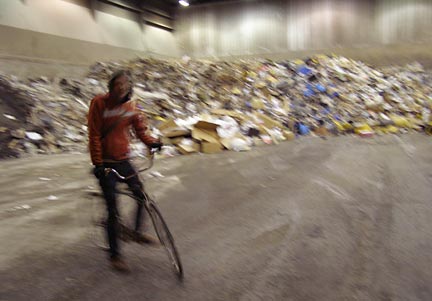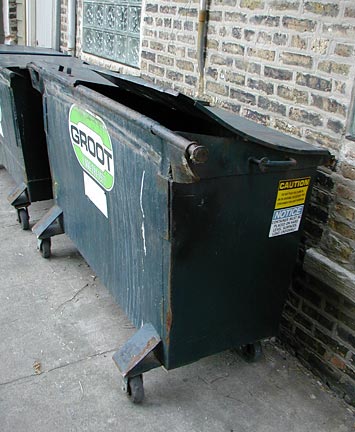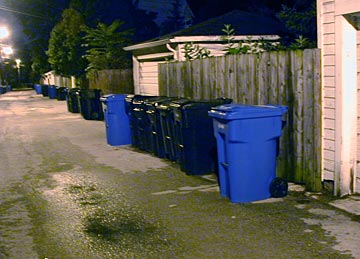Solid waste removal in any city is an enormous task, one of the main political and infrastructural challenges of urban civilization since ancient times. Chicago is surrounded by a vast hinterland of flat land on north, west and south, so finding places to dump waste has never been as much of a problem as in other cities built in tighter quarters. In the nineteenth century there were a number of dump sites on the edges of the settled city, unsanitary and fetid places haunted by rag pickers and impoverished children. Garbage collection in poor neighborhoods was always poor or non-existent as well. One of the hard-won victories of Progressives such as Jane Addams was to establish dependable garbage disposal throughout all areas of Chicago in the 1890s. Eventually garbage was sent farther from the city and the old dumps were turned into new uses, such as Riverview Amusement park at Western and Belmont.
For much of the twentieth century Chicago dumped its solid waste in the swampy areas south of the city around Lake Calumet. For nearly one hundred years the stream of refuse built up into high mountains visible for miles across the flatlands. By the 1980s these landfills were nearing their legal limits of use. All across the U.S., municipalities were belatedly forced to cap off landfills which failed to meet the new requirements in effect from the Resource Conservation and Recovery Act of 1976. It was a national crisis which pushed cities to adopt recycling as a solution to try to lessen the unstoppable torrent of waste. At the same time, many of the steel mills and other heavy industries on the South Side of Chicago were shutting their doors. The communities south of Lake Calumet, already surrounded on all sides by enormous landfills, and the most polluted neighborhoods in the US, were tempted by a Faustian bargain to open new sanitary landfills in Dolton with promises of cash for a struggling suburb and jobs for residents against howls of protests by environmentalists and other nearby residents. But the landfills of Calumet were capped off one by one, and in the early 90s Chicago got a recycling program, the Blue Bag program started by newly-elected Mayor Daley. Chicago's garbage now heads farther afield to landfills in southern Wisconsin, central Illinois and northwest Indiana.
Garbage collection in Chicago has never been tainted by the mafia control and violence prevalent in New York City. But that does not mean that it is a clean business here, as garbage haulers have been involved again and again in bribery, kickbacks and illegal dumping schemes exposed by Operation Silver Shovel and the Hired Truck scandals. The sanitation industry is a murky mix of smaller private contractors, multinational corporate haulers and public employees that is largely obscure and ignored by ordinary citizens. One of the world's largest garbage-collection companies, Waste Management Inc, started in nearby Oak Brook (though now based in Houston). However, most apartment blocks in the city are serviced by independent firms such as Groot, Allied Waste, or Homewood. Despite Chicago's claims to be a leading environmentally conscious city, the official Blue Bag recycling program has never been much of a success. Unlike many other cities which separate collection of recyclables from ordinary waste, under the Blue Bag program citizens mix all recyclable materials in blue trash bags and toss them in ordinary garbage bins. City garbage trucks compact all the materials together and dump it all at a recovery facility where workers pull out the mangled blue bags and whatever salvageable glass, paper or plastic has survived the process. The mangled and mixed materials recovered are not of the highest quality, so the city has never made much money from the salvaged resources. Most multi-unit buildings in the city do not use city garbage removal. Instead, they are serviced by independent contractors who are not required to sort out the Blue Bagged recyclables. So if you live in an apartment, chances are that your recyclables are simply being sent the landfill, whether you sort them or not, no matter whether the Blue Bag system does anything anyway. Is enough to make most residents in Chicago cynical about recycling and disinclined to make any effort toward a better solution.
Since 2007, some wards of the city have adopted a separate collection system for recyclables, using blue plastic bins similar to the standard black garbage bins. The new bins have greatly increased the amount of materials recycled and number of residents participating, so that they will eventually be rolled out across the entire city, and in time the Blue Bag program will be discarded as it should have been long ago. |


